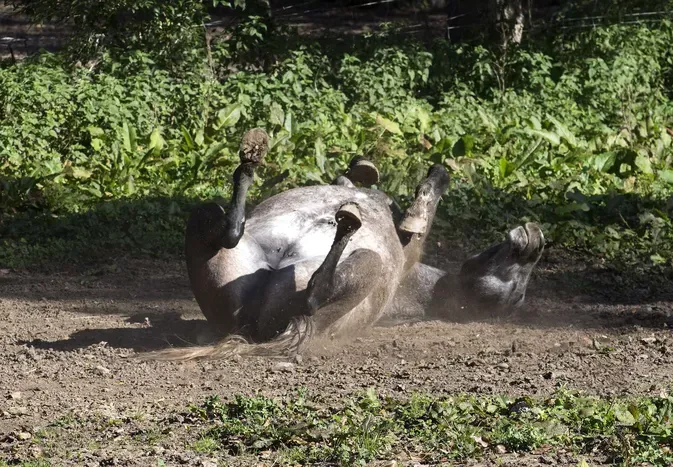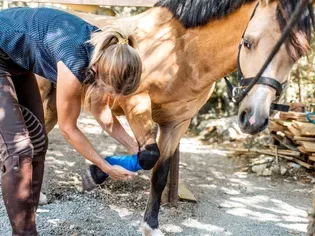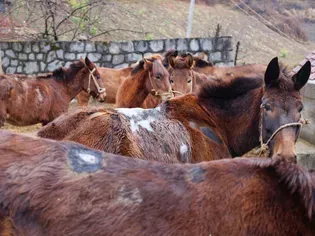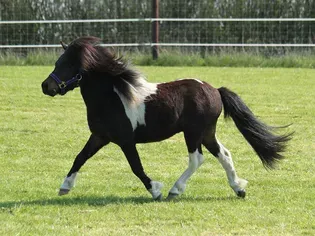Mange in Horses
Updated on 04/26/24

Manege in Horses: A Comprehensive Guide to Prevention, Treatment, and Recovery
Introduction:
Mange is a common skin condition that affects horses of all ages and breeds. It is caused by tiny parasitic mites that burrow into the horse's skin, causing intense itching, hair loss, and inflammation. If left untreated, mange can lead to serious health problems and even death.
In this comprehensive guide, we will delve into the world of mange in horses, exploring its causes, symptoms, diagnosis, treatment options, and preventive measures.
Causes of Mange:
There are two main types of mange that can affect horses:
* Sarcoptic Mange: Caused by the Sarcoptes scabiei mite, this is the most common type of mange in horses. The mites burrow into the horse's skin, causing intense itching and crusty, scaly lesions.
* Chorioptic Mange: Caused by the Chorioptes bovis mite, this type of mange affects the lower legs and tail of the horse. It causes crusty lesions and severe itching, leading to hair loss and scabs.
Symptoms of Mange:
Recognizing the symptoms of mange is crucial for early detection and treatment. Common symptoms include:
* Intense itching and restlessness
* Hair loss in patches
* Crusted, scaly, or scabby lesions on the skin
* Thickening and wrinkling of the skin
* Lethargy and loss of appetite
* Secondary skin infections
Diagnosis of Mange:
If you suspect your horse may have mange, it is essential to consult a veterinarian for a proper diagnosis. They will perform a physical examination and may take skin scrapings to look for mites under a microscope.
Treatment Options:
The treatment for mange depends on the type of mite causing the condition. Common treatment options include:
* Antiparasitic Medications: Topical or oral medications are used to kill the mites and stop the itching.
* Medicated Shampoos and Dips: These products contain antiparasitic agents that help kill the mites and soothe the skin.
* Injections: In severe cases, injections of antiparasitic medications may be necessary.
It is important to follow the veterinarian's instructions carefully and complete the full course of treatment to ensure complete eradication of the mites.
Prevention of Mange:
Preventing mange in horses is essential for maintaining their health and well-being. Key preventive measures include:
* Quarantining Infected Horses: Isolate any horses suspected of having mange to prevent the spread of the mites.
* Regular Grooming and Bathing: Regular grooming helps remove dead skin cells, dirt, and dander that can harbor mites. Bathing with medicated shampoos can also help prevent infestations.
* Disinfecting Tack and Equipment: Clean and disinfect all tack and equipment that comes into contact with infected horses to prevent the mites from spreading.
* Treating Potential Carriers: Horses that have been in contact with infected individuals should be treated with antiparasitic medications as a preventive measure.
Conclusion:
Mange is a preventable and treatable skin condition that can have a significant impact on a horse's health and well-being. By understanding the causes, symptoms, diagnosis, and treatment options for mange, as well as implementing effective preventive measures, horse owners can ensure the health and happiness of their beloved animals.
Remember, early detection and treatment are crucial for successful management of mange in horses. If you suspect your horse may have mange, do not hesitate to contact a veterinarian for professional guidance.
Explore More Pets

Pony Breeds
The Difference Between Horses and Ponies

Horse Diseases & Conditions
What Do I Do If My Horse Colics?

Pony Breeds
Horse and Pony Care by the Day, Week, Month and Year

Horse Diseases & Conditions
Grease Heel in Horses

Light Horse Breeds
Gypsy Vanner Horse Breed Profile

Horse Diseases & Conditions
Girth Galls and Saddle Sores

Pony Breeds
Shetland Pony Breed Profile

Horse Diseases & Conditions
Hay Belly in Horses